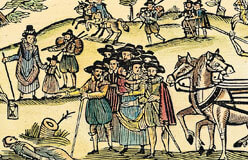The First Folio, published in 1623, divided Shakespeare’s plays into comedies, tragedies, and histories.
Comedies are meant to make an audience laugh. Characters do foolish things and learn lessons by having jokes played on them. In A Midsummer Night’s Dream, for example, the weaver Bottom takes himself too seriously as an amateur actor. The result: he is transformed into an ass, with long ears and a hairy face. To make matters more ridiculous, he is wooed by the beautiful queen of the fairies, Titania, who is herself under a spell. In Much Ado About Nothing, Beatrice and Benedick think they hate each other and make fun of people in love. But their friends trick them into falling in love by saying that each one is secretly in love with the other.
Shakespeare’s comedies are romances, and they have happy endings. But first, the characters have to overcome one problem after another. Even though young love wins in the end, Shakespeare has fun showing “what fools these mortals be.”







